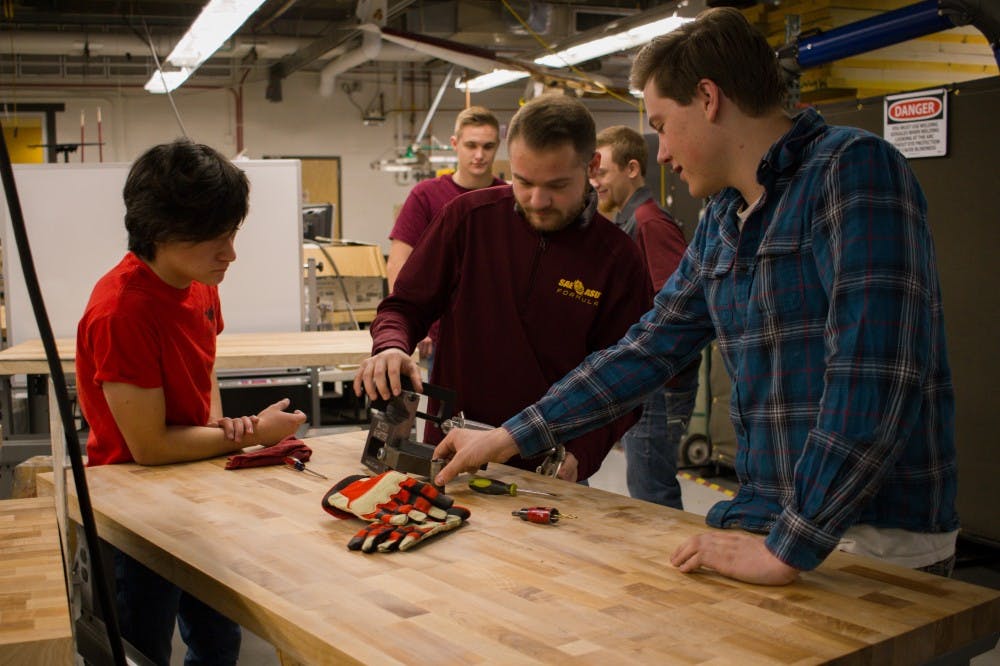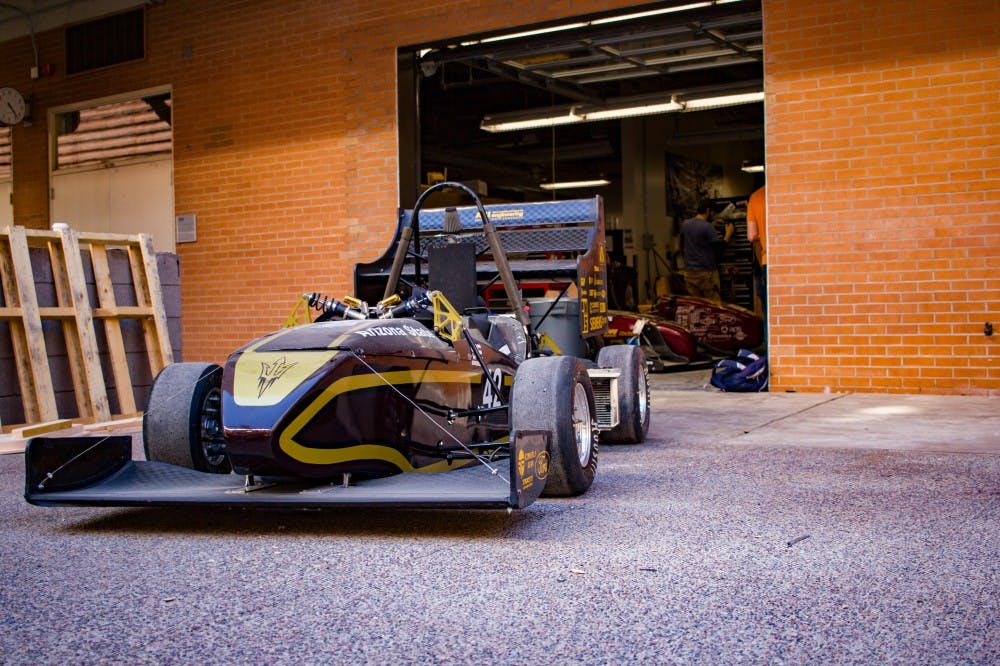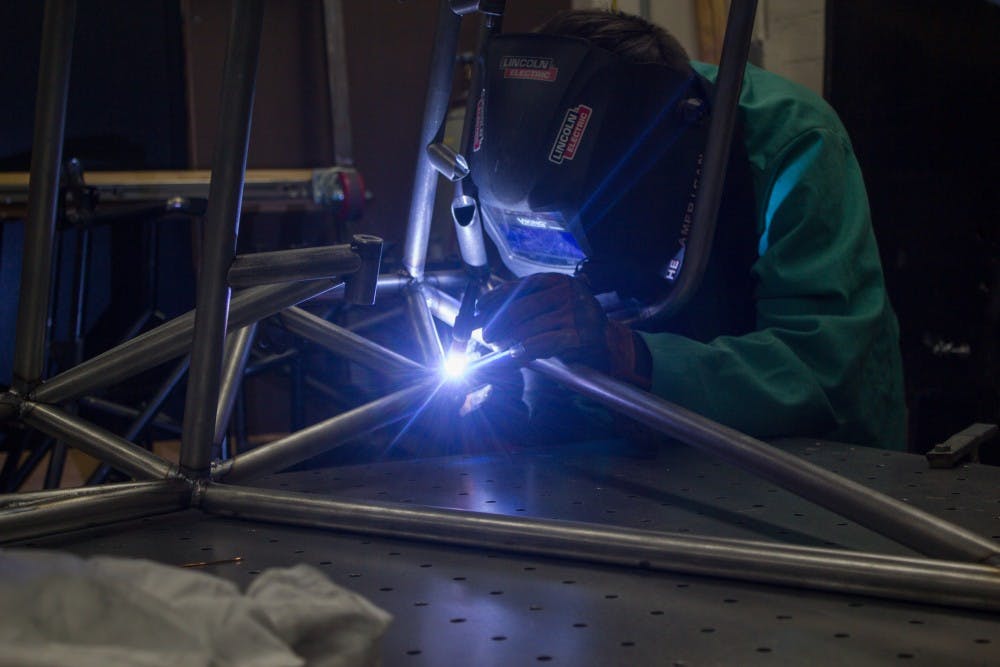$30,000. That’s how much it costs to build a race car — and that's only one part of the complexity faced by the ASU students who are doing just that.
These are students ranging from freshmen to seniors working together to build a car to pitch to companies like Ford and Tesla. Think of it like a student version of Shark Tank, where every concept is a different race car. The minutiae between them is often the deciding factor for whether the "sharks" bite.
“(It's) everything that you would do to justify financially why your business should succeed and why people should invest in it, as if you were going on Shark Tank,” said mechanical engineering senior Michael Kuntz, chief engineer of Sun Devil Motorsports.
This club was started in the 1980's. Back then, it was a small club that was more connected to what students were learning in the classroom than it is now — its main purpose used to be research. The club was only around for a few years before it fizzled out.
The club was revived in 2015. The Sun Devil Motorsports of today has only been around for four years.
In 1992, it made one of the top cars in the Society of Automotive Engineers (SAE) at the time — it was the first carbon fiber monocoque (the structural skin of the vehicle) that was ever in the SAE international competition, and it was the first and only monocoque that ASU has ever produced, according to Kuntz.
“We still have that car somewhere in storage,” Kuntz said.
They used carbon fiber for the chassis instead of steel. That’s half the weight of steel, and twice the strength.
Contrary to popular belief, this is not a racing club. It operates more like a small automobile manufacturer. The nearly 100 students involved in the club are further divided into various sub-teams that are each in charge of building and developing a certain aspect of the vehicle.
For example, there are sub-teams dedicated to vehicle dynamics, the engine, frame, chassis, drive train and components from the engine to the wheels. The club also has an aerodynamics team, a team focused on data acquisition, a systems sub-team — which is basically everything the driver touches and interacts with, such as the steering wheel, pedals and seat — and it even has a team that focuses on the environmental safety of the vehicle.
How to build a formula-style race car
The students eat, sleep and breathe automobile parts as they work on building the car any chance they get, while simultaneously balancing coursework. They work with their respective sub-teams and come together to build the finished product using 5S and Six Sigma, which are buzzwords for manufacturing processes.
“The whole idea behind Six Sigma is you reduce the variation in your parts by being a very organized individual,” Kuntz said. “And, well in our case, a very organized entity.”
So how do they do it?
Manufacturing a formula-style racing vehicle surely can’t be as easy as putting together a bunch of parts. Where are these students getting the materials to build the components?
The students first use a software called Dassault Systemes that allows them to make 3D models for all the components. The software allows them to make a blueprint of the component with measurements, and any machinist should be able to fabricate the part from that blueprint.
The students use $10,000 recieved from ASU and a grant from Ford to buy parts and materials, but they also receive material, parts and labor sponsorship.
“I think a lot of the components, they put together here,” said mechanical engineering senior Zach Hinderman, drivetrain lead engineer. “They buy all the components separately and then put it together into a system. So we make sure everything is where it needs to be. The people who are building systems have only what they need ... they can focus on that task and make sure it gets done on time, safely and cleanly.”
Building the car isn’t all that those in the club to do. They aren’t just the factory, they’re the whole automobile company. The students also market the car to the judges at the SAE and convince them that it is worth the asking price.
The judges, who are from companies like GM, Ford, Tesla and SpaceX, pick apart their entire design and every decision they make in the process of building this car. They are judged on how the car was built and how it performs, as well as how it is presented by the business team.
The business presentation includes a market analysis, a business plan, a production plan, production cost per unit, projected investment return and how much money the team is asking of the judges.
"That's what teams have to do on top of (building the car)," Christopher Wilkes, the club's adviser and a supervisor of engineering technical services said. "So it's not just engineering; you have to run it as a small car company."
The judges scrutinize the vehicle, then ask the final question, “Alright, so you’ve made a car. How are you going to market it and make an actual company out of this?”
And then, it’s only after all of this that they actually get to drive their car and show that it lives up to the hype.
Because this club is only about three years old, it is only just beginning to climb in the ranks at SAE International. In its first year, its goal was to finish building a car. The second year, its goal was to finish all the events at the competition. This year, the club's goal is to build a reliable car that doesn’t break right after the event.
Fine-tuning the organization
Relative to all the moving parts necessary to effectively running the club, it has faced issues with project management and forming a dedicated business team.
It also found issues with sponsorship and making sure they’re organized.
“Our business team’s been a major thing this year,” Wilkes said. “If you’re usually doing engineering, you really don’t want to deal with the events, if you’re anything like myself.”
This year was the club’s first time reaching out to the business school at ASU — it wants to encourage students of any major to come in and put their skills to use.
Wilkes said their successes aren’t in the competition itself, it’s in building the team and getting into repetition. The students want to make sure they are building as much of the car as they possibly can.
“There’s a lot of manufacturing processes that weren’t being done in-house, and that’s the whole point of the club, right?” Wilkes said in reference to the club’s goals for this year. “Zack is doing a lot of the machining himself. He’s probably getting a lot of education just from the hands-on (experience).”
They have a development team now that helps freshmen students get exposure to each sub-team and let them decide what path they want to take. The club also considers its success based on what alumni do after graduation. They’ve had members go work for Ford, Honda, ZF, etc. right out of college.
The club plans to get this year's car ready in February for the competition in June, and they're aiming for gold by making it in the top 10 or even top three.
Reach the reporter at ranjanivk@gmail.com or follow @RanjPhoenix on Twitter.
Like State Press Magazine on Facebook and follow @statepressmag on Twitter.






